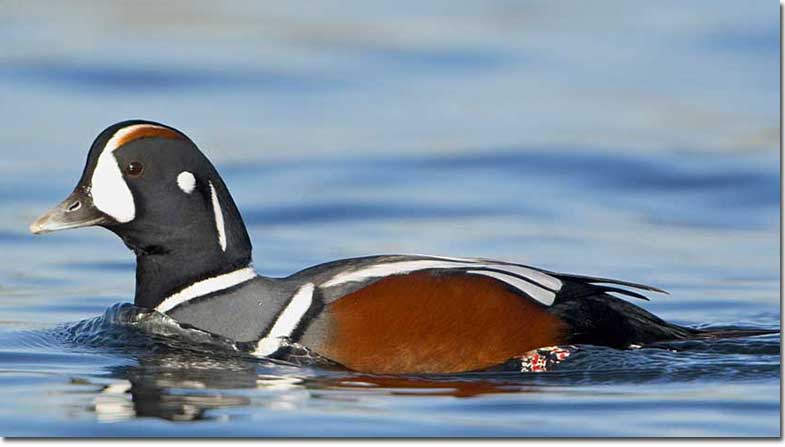The Harlequin Duck is a small, uniquely patterned gray duck with white and chestnut patches.
In summer, we find this bird breeding in clear, fast rivers from Alaska to Montana, coastal eastern Canada, Greenland, Iceland, and northeastern Asia. In winter, they live in coastal waters a bit south of their breeding range.
Watch for small groups of this beautiful little duck diving in cold, swift rivers, and around coastal jetties.
On this page
Identification
The Harlequin Duck is small, teal-sized duck with a stubby gray beak. Males are usually a little bit bigger than females but on average this bird is 16 inches long, has a 26 inch wingspan, and weighs 1.3 pounds.
Male Harlequin Ducks have a long, pointed tail, and are slate gray with chestnut flanks, and a bit of chestnut on their head. They also have prominent (seemingly random) white patches on their head and back, and two white bands on their chest.
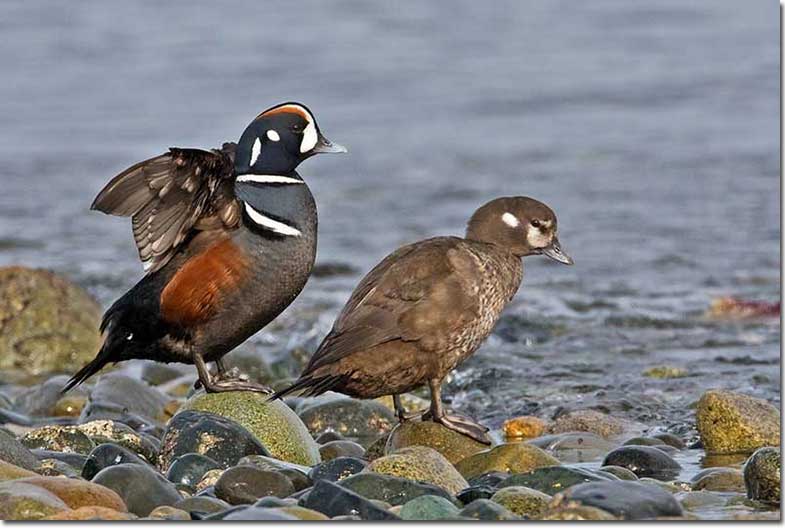
Harlequin Duck pair
The female Harlequin Duck is dark brown with a blurry white patch on her face and a small, round white mark near the back of her head. She has a white belly and also has a pointed tail but it’s not as long.
Like most ducks, this species has fast direct flight on rapidly beating wings. When flying, the female looks like a small dark duck with dark wings and a white belly. Males in flight are small dark ducks with mostly dark wings and some white marks on their head and chest. In good lighting, you can also see their chestnut flanks.
Related: “Odd” Ducks
Young male Harlequin Ducks and adult males from July to September resemble females but have some chestnut on their flanks and a bit of white on their backs.
Food
Harlequin Ducks feed on insects, fish eggs, crustaceans, mollusks, and other small sea creatures. In summer, their diet mostly consists of aquatic insects and fish eggs. They eat a lot of midge larvae along with larvae of mayflies, caddisflies, and other insects that live in cold, clean rivers.
In winter, this species changes its diet and mostly feeds on invertebrates that live in rocky coastal habitats. They eat many crustaceans, mollusks such as Blue Mussels and other similar species, isopods, barnacles, echinoderms, and other small sea creatures.
On occasion, when the opportunity presents itself, they also eat small fish.
Harlequin Ducks forage for insects by dabbling and diving in fast-flowing water. They pick small bugs and their larvae from rocks and gravel on the bottom of rivers and streams, and sometimes find prey by moving small rocks with their beaks.
To find more insects and fish eggs (roe), they tend to forage where streams flow into lakes, and in rivers with good populations of trout and salmon.
In winter, this species also forages by diving and picking food from rocks and boulders. They won’t hesitate to dive in fast flowing rapids, and also prefer jetties and other rocky spots with heavy wave action.
Nesting and Eggs
Harlequin Ducks form pairs in late fall, usually finding a mate by December. Males can help pick a nesting site but the female usually does most of the work. After exploring various spots along a stream or river, she picks a spot with some overhanging cover, close to the water.
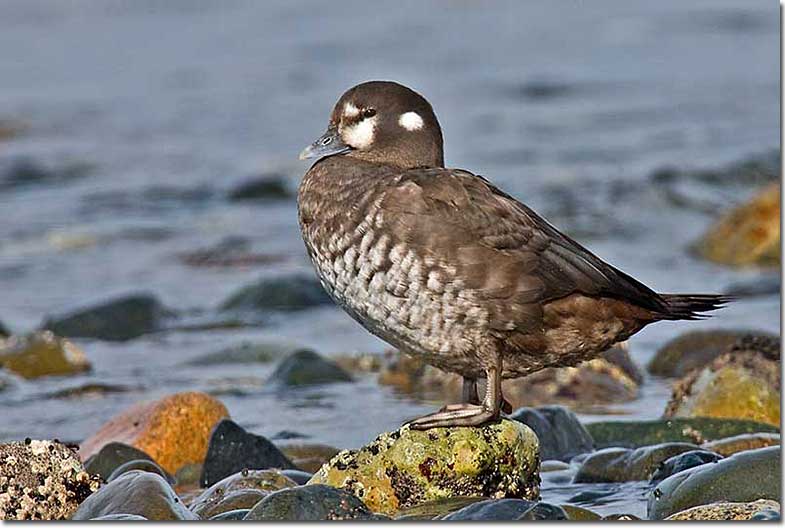
This can be a spot under a bush or next to a tree, on a cliff ledge, behind a waterfall, or other situations. In some places, these ducks also nest in tree cavities. Once she picks a suitable site, the female Harlequin Duck makes a basic nest with conifer needles, moss, and a few other objects.
She lines the nest with down feathers and lays six plain buff or cream-colored eggs. The female incubates them for 28 days and can bite or hiss at people that try to pick her up.
A day or two after hatching, the ducklings leave the nest and follow their mother to an area of slow-moving water with an abundance of insects. The young birds feed themselves although they still stay near their mother. They can’t dive until they are three to four weeks old.
When they can fly, (55 or 56 days after hatching), the young birds move to coastal sites. Some migrate with their mother, others on their own.
Current Situation
Harlequin Ducks breed in cold, clear rivers and streams from Alaska south to western Canada, and western Montana, Greenland, and Iceland. They also breed in similar habitats in eastern Canada, and northeastern Asia.
After breeding, they move to coastal waters near breeding grounds and south to Japan, northern California, and Virginia.
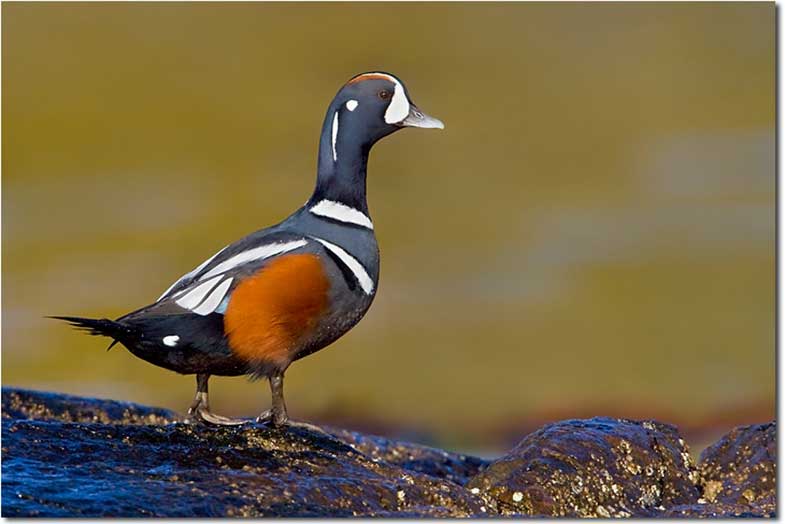
Harlequn Duck male
This species is listed as Least Concern in the IUCN Red List, but in eastern Canada, they are considered locally endangered, are threatened in Maine, and species of special concern in some other places.
Although this species has healthy populations in many areas, it is easily affected by pollution and changes to its habitat. The Harlequin Duck is very susceptible to oil spills and other forms of coastal pollution. Populations also decline when logging and hydro projects cause silting and other problems on breeding rivers.
Fortunately, some habitat protection and conservation measures have helped protect and even increase Harlequin Duck populations.
Facts
- Harlequin Ducks can dive 60 feet deep. They swim underwater by moving their feet and using their open wings to help them steer through the water.
- Many Harlequin Ducks have healed broken bones. These tough little ducks can suffer broken bones after being smashed against rocks and boulders in swift water. Studies have shown that the majority of adults have healed fractures!
- This species is also known as the “Sea Mouse” because it makes odd squeaky sounds. They have also been called, “Squeeker”, and “Blue Streak”.
- These ducks have a high rate of metabolism and have to eat a lot. For this reason, they require high-quality streams, rivers, and coastal waters with plenty of insects, crustaceans, and other food items.
- The Harlequin Duck is the only duck species in North America that requires fast-moving rivers. It thrives in rapids and rough coastal waters and, unlike most other duck species, rests by perching on slippery rocks instead of floating on the water.
Similar Species
The Harlequin Duck is one of the more unique duck species on the planet. Not many birds can be confused with it but there are a few species that have some similar markings.
Bufflehead
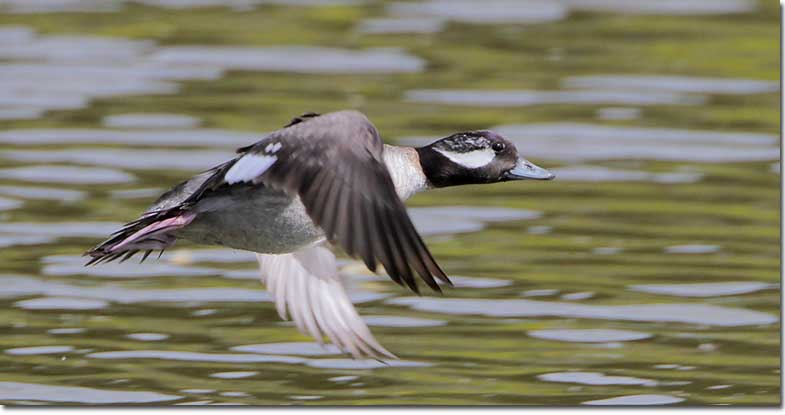
The female Bufflehead is another small, gray-brown duck with a white mark on its head. It looks a bit like the female Harlequin Duck but the female Bufflehead doesn’t have any white markings just behind its bill.
Surf Scoter
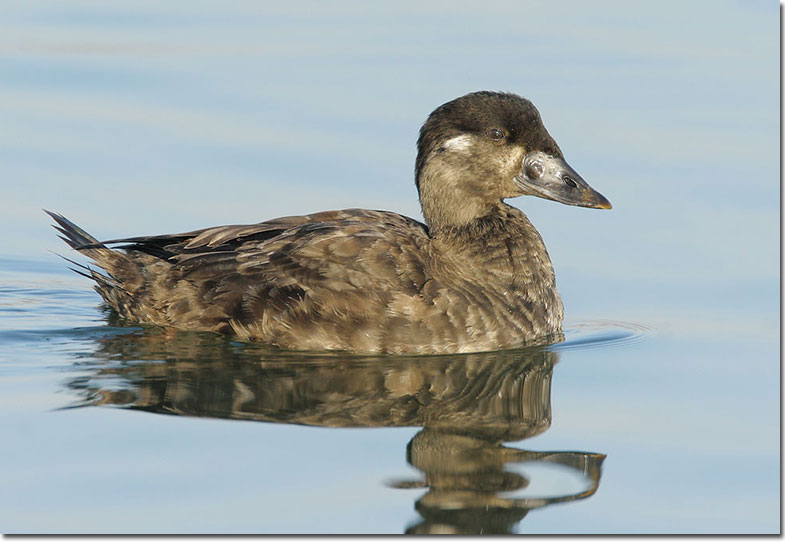
The female Surf Scoter is another dark brown duck with white markings on its face. However, this species is much bigger and bulkier than the Harlequin Duck. It also has a large beak.
White-winged Scoter
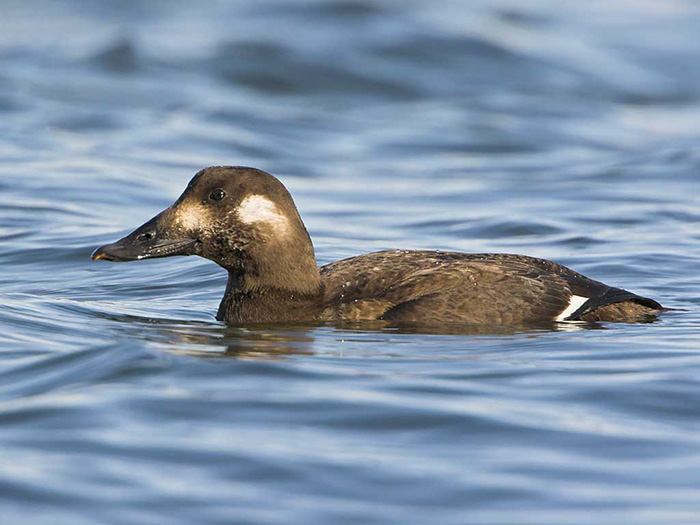
The female White-winged Scoter is another duck species with a head pattern a bit like that of a female Harlequin Duck. Even so, it is much bigger, has a flatter head with a larger, longer beak, and has a big white patch in its wings. The female Harlequin Duck’s wings are all dark.
Frequently Asked Questions
Why is it called Harlequin Duck?
It is called the Harlequin Duck because of the breeding male’s fancy plumage. It looks like someone decorated this duck with a variety of white shapes and markings.
How rare is a Harlequin Duck?
The Harlequin Duck is not rare, at least in its typical range. However, they are usually seen in very small groups and are far from abundant.
Where is the Harlequin Duck found?
The Harlequin Duck is found in the cold waters of northwestern North America, eastern North America wintering south to Virginia, in northeastern Asia, and in Greenland and Iceland.
Are Harlequin Ducks friendly?
Harlequin Ducks are pretty friendly birds. Many are fairly tame and don’t mind people watching them from close range.

